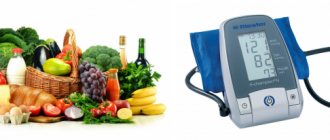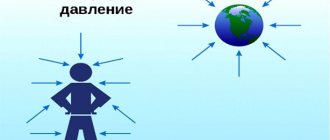How does a person's blood pressure change?
Blood pressure constantly changes throughout the day and day.
At night, when a person sleeps, it decreases and stabilizes to normal values. In the morning after waking up, blood pressure rises and stabilizes during the day. In the evening, when you rest, the levels begin to rise slightly again and stabilize during sleep.
Lose extra pounds and watch your figure
Blood pressure often increases as weight increases. Excess weight can also cause trouble breathing during sleep (sleep apnea), which further increases your blood pressure.
Weight loss is one of the most effective lifestyle changes for controlling blood pressure. So, according to research, losing just 4.5 kg can already help lower blood pressure.
Pay special attention to the waist. A waist circumference of 102 cm for men and 89 cm for women significantly increases the risk of high blood pressure.
Why are indicators changing?
Throughout the day, blood pressure can rise and fall by several units and often people do not notice this.
Factors that influence this:
- The time of day at which measurements are taken. So, if you measure the indicators in the morning, and even in a supine position, then the numbers are overestimated. During the day, on the contrary, the values fall. In the evening, the pressure rises slightly again. At night it subsides because the person is in the most relaxed state.
- Passion for coffee drinks affects blood pressure! Caffeine quickly increases blood pressure. The same goes for alcohol.
- Stress, anxiety, overwork, work pressures are one of the common reasons why the numbers are inflated.
- Changes and surges in blood pressure may be due to chronic lack of sleep.
- Disturbances and changes in the functioning of the endocrine system also affect the malfunction of the cardiovascular system. This factor concerns mainly women during menopause or menstruation.
- Climatic conditions. Due to the cold, the patient's blood pressure may be elevated.
- Unstable pressure also occurs with VSD (vegetative-vascular dystonia), often in this case it decreases.
- Various heart diseases (arrhythmia, angina).
- Some medications also affect blood pressure, so be sure to check the possible side effects before taking medications.
When measuring indicators, be sure to relax and remove the phone away from the device.
If the indicators show high numbers, then this may be a signal of persistent hypertension.
This condition is especially dangerous if there are other symptoms. For example, headache, nausea, weakness, coordination and vision problems, chest pain, etc. In this case, immediate consultation with a doctor is required.
Can blood pressure change in a short period of time?
Can the pressure change in a few minutes, that is, very quickly? Rapid changes in the state of blood pressure occur against the background of strong atmospheric changes, even in people with problem-free health, not only throughout the day, but also in a very short time, for example, in a matter of minutes.
The reason for this may be:
- Severe physical stress. Difficult working conditions, emergency work mode and other extraordinary situations can lead to an immediate increase or decrease in pressure.
- Diet. A sudden jump in blood pressure often occurs after eating an excessive amount of trigger foods (coffee, salt, chocolate, sugar, fast foods, etc.).
- Taking medication. A rapid increase in blood pressure is caused by Paracetamol, anti-inflammatory and vasoconstrictor medications. Drugs of the narcotic group provoke sudden fluctuations in blood levels, which pose a clear threat to humans.
- Bad habits. Excessive alcohol consumption and frequent smoking, as well as hangover syndrome, lead to a narrowing of the vascular lumen, thereby contributing to a rise in blood pressure.
- Menstruation. In women, a change in pressure over a short period can occur in the middle of the menstrual cycle or several days before the onset of “red days”. In this situation, there is a rapid decline.
- Pregnancy. During the period of bearing a child, dramatic changes occur in the female body, the cardiovascular system experiences especially increased stress, which leads to sudden sharp changes in blood pressure.
- Overexcitation of the central nervous system. Prolonged fatigue, stress, excessive joyful and negative emotions, and doing hard work can cause a rapid rise or fall in blood pressure.
- Meteor dependence. A sharp change in weather conditions has an extremely negative impact on the blood pressure of people who do not tolerate weather changes very well.
- Traveling by plane. The pressure in the cabin of an airliner during flight is equal to atmospheric pressure at an altitude of 2.5 thousand meters above sea level. When the atmospheric level decreases, the volume of oxygen in the cabin of an air machine decreases significantly, which leads to a sharp increase in blood pressure in humans.
- Other situations. Hiking high in the mountains or diving into the sea at great depths provoke an immediate increase in blood levels.
Is there a norm
When diagnosing blood pressure, there is the concept of upper (systolic) and lower (diastolic) pressure.
Normally, the upper values should range from 110 to 140 mm. rt. Art., and the lower numbers should not be less than 70 mm. rt. Art.
Depending on the characteristics of the body, blood pressure may vary for each person. There is also such a thing as “working” pressure. This is a condition when the values of upper and lower blood pressure may deviate from the norm, but the person feels normal. “Working” indicators can be determined by a specialist.
Table: clinical recommendations for blood pressure norms
| Age | Upper blood pressure readings (mm Hg) | Diastolic blood pressure indicators (mm Hg) | Pulse (beats per minute) |
| 0–12 months, boys | 96 | 66 | 130–140 |
| 0–12 months, girls | 95 | 65 | 130–140 |
| 2–10, boys | 103 | 69 | 95–100 |
| 2–10, girls | 103 | 70 | 95–100 |
| 11–20, boys | 123 | 76 | 70–80 |
| 11–20, girls | 116 | 72 | 70–80 |
| 21–30, men | 129 | 81 | 60–80 |
| 21–30, women | 127 | 80 | 65–90 |
| 31–40, men | 129 | 81 | 70–80 |
| 31–40, women | 127 | 80 | 75–85 |
| 41–50, men | 135 | 83 | 70–80 |
| 41–50, women | 137 | 84 | 75–90 |
| 51–60, men | 142 | 85 | 65–75 |
| 51–60, women | 144 | 84 | 65–80 |
The most optimal indicators are 120 by 80 mm. rt. Art.
But even here there are boundaries that are also normal or relatively normal:
- 130 to 85 mm Hg. Art.
- 130 (139) by 85 (89) mm. rt. Art. - normal blood pressure, but slightly elevated.
You also need to take into account the patient’s age when taking measurements:
- For boys over one year old, the optimal values are 96 by 66 mm. rt. Art., and for girls – 95 to 65.
- For children over ten years old – 103 to 69 (figures for boys) and 103 to 70 (for girls);
- For people over twenty years old - 123 to 76 (values for guys), 116 to 72 (for girls);
- For older people, the numbers also change! In this case, men can have optimal indicators of 142 over 85, and women - 144 over 85.
With age, normal blood pressure values increase slightly, so this factor must also be taken into account when taking measurements.
Negligence syndrome
The reason for the revolution is the “white coat syndrome”: patients often react nervously to specialists in such a uniform, and when the doctor measures blood pressure, it turns out to be higher than usual. As a result, the number of patients includes pseudohypertensives, the average blood pressure figures for the nation are higher than the real ones, and more medications are taken than necessary. At a doctor's appointment, the syndrome occurs in approximately every fourth patient.
“Even in England, where daily monitoring is recommended for absolutely all patients, there are doubts that this will be carried out,” says Yuri Vasyuk , a famous cardiologist, professor, vice-rector for medical work at Moscow State Medical University. “There simply aren’t enough devices there to be enough for all patients with hypertension. Let's be realistic, there won't be enough of them in Russia either. I think for many such research would even be unnecessary.
For example, if the patient is young enough, his high blood pressure was recently diagnosed, reached relatively low numbers and is well controlled with medications, and there are few or no risk factors and complications of hypertension. Here daily monitoring will be redundant. Russian guidelines on hypertension provide for situations where monitoring is advisable. It is important for elderly patients, especially with diabetes, obesity, other risk factors, and damage to target organs - heart, kidneys, blood vessels.
There is a group of patients who simply need it. First of all, these are patients with labile blood pressure - their blood pressure “jumps”, changes throughout the day, and there are even episodes of low blood pressure. Today it is even believed that high blood pressure numbers are not as scary as their changes from high to low, and vice versa. For example, if at night the pressure decreases by more than 20% of the daytime level, this significantly increases the risk of ischemic stroke, which reduces blood flow to the brain. If the pressure at night, on the contrary, is high, then there is a high risk of bleeding in the brain (hemorrhagic stroke). In all such cases, daily monitoring is very important; it will help select treatment to avoid these and other complications of hypertension.
How to measure blood pressure correctly
To avoid possible pathologies and serious diseases, even a healthy person needs to measure their blood pressure once a month. However, you need to measure it correctly and be better prepared before doing so.
How to prepare for diagnosis:
- It is not recommended to drink strong tea and coffee. You must refrain from doing this at least an hour before the test.
- It is also recommended to avoid sports and cigarettes.
- If you need to take any medications, read the instructions. Many drugs affect the cardiovascular system. It is better to give them up during the study.
- Before starting the measurement, the patient must rest for at least 7-10 minutes.
Following these recommendations will help determine normal blood pressure readings and identify possible deviations.
Changing blood pressure at least 3 times during the day will give an accurate idea and a signal for consultation with a doctor.
How to measure blood pressure using a tonometer:
- Sit comfortably, relax the muscles of your arm and place it on the table. Place a cuff on the shoulder in proportion to the position of the heart.
- Make sure the cuff size matches your hand size as closely as possible. You need to be especially careful if the patient is overweight.
When is the best time to take measurements:
- First in the morning - although an hour after sleep and on an empty stomach.
- In the evening - either before dinner or after dinner, two hours later.
It is advisable to take measurements twice, leaving an interval of at least a minute between measurements.
It is best to write down the indicators somewhere. If the difference is small, then there is no need to worry - this is normal. If the values are very different, then you should definitely consult a doctor.
ABPM method - daily monitoring
Daily blood pressure monitoring allows you to identify hidden pathologies and diseases.
This is a measurement of pressure using automatic special equipment. Such a study lasts at least a day. The device independently saves readings at a certain time. This method is used to find out which values are optimal for a patient depending on the time of day. You can diagnose hypertension and (if it exists) select the appropriate medications.
The cuff is placed on the patient's shoulder and the monitor is placed (either on a belt or on a belt). In this case, a person leads a normal lifestyle, carrying a special device with him.
How is blood pressure monitored?
You should refrain from smoking 60 minutes before the procedure.
To obtain information about your health status and prevent the development of pathological conditions, you need to monitor pressure fluctuations throughout the day. The correct result is achieved by taking measurements at the same time, and in the same body position. Measuring blood pressure is one of the diagnostic methods. When using it, it is important to follow the basic recommendations in order to obtain undistorted information:
- Do not smoke, drink caffeinated drinks or alcohol, exercise, or take medications that can affect blood pressure values approximately 1 hour before the measurement.
- It is important to take a comfortable position (sitting on a chair), with your hand lying on the surface at heart level.
- During the procedure you cannot move or talk.
When determining blood pressure in both arms, a difference of 10-15 mmHg may be observed. Art. This is considered completely normal. But if measurements have not been taken previously and the person does not know his characteristic physiological pressure norm, it is important to take measurements alternately on both hands. You should take as a basis the readings on the hand on which they are larger.
Sound method
The second name of the most common method is the Korotkov method. Pressure measurements are carried out using a hand-held tonometer. To do this, a cuff is placed on the arm and the brachial artery is compressed by pumping air into it. When it is released slowly, tones are heard. The disadvantage of this method is the sensitivity of the tonometer to ambient noise.
Electronic measurement
The most reliable blood pressure readings are obtained using oscillometry.
The oscillometric method is the most accurate and eliminates the possibility of errors. The technique is sensitive to pulsation and immediately detects it as blood passes through the artery in the area of the arm compressed by the cuff. Noise is an interference and does not affect the receipt of accurate information, and special knowledge and skills are not required to measure blood pressure.
Daily monitoring
The daily tracking method (ABPM) allows you to get an accurate picture of deviations over 24-48 hours, and determines how these changes depend on physical activity. For this purpose, a person wears a special device for a day or two; he takes measurements every 10-15 minutes. This allows you to understand when your blood pressure rises during the day and what is causing it. It is important that when carrying out monitoring, a person should not limit his or her movements.
Treatment and prevention
If during the study serious deviations are found to be greater or lesser, then this may be hypotension or hypertension. It is best to contact a cardiologist immediately to prevent complications in other organs.
Hypertension is usually treated with diuretics - this is the safest and most effective way to treat the disease. Traditional methods are also used: rosehip decoctions, compresses with apple cider vinegar, hot foot baths, mumiyo.
Treatment must be individualized! Typically, herbal remedies, massages, and acupuncture are used for this.
But it is better to prevent the disease if you watch your diet. It is important to avoid excessive stress and stress; it is enough to be in the fresh air and do exercises in the morning. It is also not recommended to indulge in smoking and alcohol.
Constant jumps in blood pressure throughout the day can be very dangerous. After detecting them, it is better to inform your general practitioner or cardiologist about this.
It is better to monitor your health - this will help to avoid the occurrence of serious diseases that can lead to a heart attack or stroke.
Author of the article Svetlana Anatolyevna Ivanova, general practitioner
And about medications
Do not self-medicate, do not listen to the advice of friends and neighbors. There are several groups of medications that lower blood pressure, and only a doctor can determine which drug should be taken at the moment.
Hypertension cannot be cured using folk remedies. Follow your doctor's recommendations and take the medications he prescribed for you.
Every Moscow clinic has health centers where you can get doctors’ recommendations on preventing hypertension. Many medical institutions operate schools for patients with arterial hypertension, where qualified specialists explain why hypertension is dangerous and how to treat it.
Are constant pressure fluctuations normal?
Normal blood pressure is a sign of a healthy cardiovascular system. By medical standards, the norm is 120/80 mmHg. Art. If the readings are higher or lower, the doctor may suspect some problems that the patient may not even be aware of.
Optimal performance
These figures are only average medical parameters, the boundaries of which are quite flexible. So, the upper limit of systolic pressure is 140 mmHg. Art., and the lower one - 110 mm Hg. Art. The upper limit of diastolic is 90 mm Hg. Art., and the lower one - 70 mm Hg. Art.
Each person is individual, therefore, in addition to the meaning of the norm, doctors established the term “working pressure”. This concept applies to people whose indicators do not fit into the optimal range, but this does not affect their well-being in any way.
Complications of hypertension
Many people know that high and low blood pressure is bad for a person. But other than feeling unwell, what can this problem cause?
Don't tolerate high blood pressure
Now hypertension can be cured by restoring blood vessels...
>
Hypertension can cause the following complications:
- Heart problems. It is this organ that suffers first. Hypertension increases the lumen of blood vessels, which causes the heart to process blood more often. The most common consequence of the effect on the heart is a heart attack.
- Disturbances in brain function. Vessels dilated during hypertension cause at a minimum a headache, and at a maximum a stroke. This is a cerebral hemorrhage caused by the rupture of dilated and thinned vessels. This causes problems with both vision and movement (a stroke often causes lifelong paralysis).
- Kidney failure. The kidneys are one of the targets of hypertension. It is these organs that are able to reduce blood pressure. It’s not for nothing that doctors prescribe diuretics as the first medicine for hypertension.
- Pathological narrowing of blood vessels. Because of this, the blood supply to all human organs deteriorates. This results in constant weakness, malaise and even fainting.
- Stroke. Occurs due to insufficient supply of oxygen and other substances to the brain, the delivery of which is reduced due to narrowed blood vessels.
- Heart attack. Hypotension affects the heart just as much as hypertension. Again, the reason lies in vascular dysfunction.
What equipment is needed to measure blood pressure at home?
To measure pressure, you can use an aneroid (manual) or digital (automatic) tonometer. Choose the type that best suits your needs. When purchasing, you should pay attention to the following characteristics:
- Size:
A very important point is choosing the correct cuff size. It, in turn, is selected depending on the size of the hand. Ask your doctor, nurse, or pharmacist to help you choose. If you use the wrong cuff size, the measurement readings may be false. - Price:
This issue may become key. The fact is that the cost of devices for home blood pressure monitoring varies significantly. Explore all local offers and find the best one. Remember that the most expensive machine is not necessarily the best or most accurate. - Display:
The measurement results that appear on the display must be clearly visible. - Sound:
You should be able to hear your own heart rate through the stethoscope.
Research shows that measuring heart rate on the wrist using special devices does not always provide accurate results. The effectiveness of this technique greatly depends on the exact location of measurement and the current body temperature. Finally, such devices are quite expensive.
Aneroid tonometer
An aneroid tonometer measures blood pressure manually. The readings are displayed on the pointer dial. The cuff is placed on the shoulder, and it is inflated by squeezing the rubber pump (bulb) with a hand.
Most often, aneroid tonometers are cheaper than digital ones. A stethoscope is usually built into the cuff, thereby eliminating the need to purchase it separately. Also, modern manufacturers often equip the device with a device that makes it easier to put on and tighten the cuff with one hand. The tonometer itself is quite compact and can be easily transported from one place to another.
Of course, this type of device also has certain disadvantages. This is a complex mechanism that can be easily damaged, causing the measurement results to become less accurate. In the absence of a special metal ring, it is difficult to put on the cuff yourself. In addition, the rubber pump used to inflate the cuff may be too tight. Finally, an aneroid blood pressure monitor may not be the best solution for people with hearing loss, as it requires listening to your own heart rate to get accurate results.
Digital blood pressure monitor
Digital blood pressure monitors are more popular among the population. Most often, they are easier to operate compared to aneroid ones. The stethoscope and measuring unit of these devices are located in the same housing. Also, such tonometers are equipped with an error indicator. The measurement results are shown on a small display and are generally easier to read than with an aneroid device. Some models even allow you to print them on paper, allowing you to conveniently keep track of readings.
Depending on the chosen model, cuff inflation can be either automatic or manual, but deflation is always automatic. Digital blood pressure monitors are ideal for patients with hearing impairments because they eliminate the need to listen to the heart rate through a stethoscope.
However, this type of device also has disadvantages. Body movements or arrhythmia can greatly affect the accuracy of the measurement results. Some models are designed exclusively for the left hand, which makes them quite difficult for at least left-handed people to use. Digital tonometers are more expensive than aneroid ones. Their cost can reach the equivalent of $100. In addition, they require batteries to operate.
Dynamics of blood pressure during the day
The work of our heart is subject to a certain daily rhythm. Accordingly, blood pressure fluctuates throughout the day. These pressure fluctuations are called the circadian rhythm. It is controlled by our biological clock. The rhythm is two-phase. Blood pressure is higher during the day when a person is active and lower at night when he is sleeping. There are two peaks of increased pressure levels. One occurs at six or seven o'clock in the evening. Then there is a steady decline. The most noticeable drop in blood pressure is in the first half of the night, when sleep is especially deep. From four o'clock a gradual increase in pressure begins. The second peak of the rise is observed in the morning, at nine to eleven o'clock. An increase in blood pressure in the morning is a natural reaction of the body to the transition from an inactive state to an active one. At this time, the sympathetic nervous system is activated, the blood vessels narrow, and the heart contracts more often.
The nature of daily pressure fluctuations is influenced by various factors, including age, type of work and even race. Blood pressure reduction during sleep may not be present in older adults and African Americans.
If the tonometer readings often differ
Enter your pressure
Blood pressure indicators are not constant; they depend on the physical and mental state of a person at certain points in life, time of day and conditions of measurement. For this reason, the tonometer must be used under the same conditions and at a certain time. It is also important to rest for five minutes before the test.
Two minutes after the examination in a supine position, it is recommended to additionally measure the pressure in a standing position to detect a sharp decrease in pressure. So-called orthostatic hypotension is most often found in older people, as well as in people with diabetes or taking.
There are cases when measurement results become constantly higher or lower, despite rest and compliance with all necessary recommendations. In this case, the tonometer is used at least three times with an interval of one minute. After this, the average value from the obtained data is calculated. It is also recommended to take a lying, standing and sitting position.
If jumps are observed constantly, and the data is noticeably higher or lower than normal, it is recommended to test the measuring device at the Metrological Laboratory or the local branch of RosTest.
Basil
Basil infusion has diuretic and anti-inflammatory properties that help control high blood pressure.
Its consumption reduces fluid retention in the body and lowers sodium levels, two factors known to increase the risk of developing hypertension.
Ingredients:
- 1 teaspoon fresh basil (5 g)
- 1 glass of water (250 ml)
Cooking method:
- Put the water on the fire, and when it boils, add the basil.
- Remove from heat, cover and let steep for 10 minutes.
Method of consumption:
- Drink 2-3 cups of basil infusion per day, at least 3 times a week.
Why does the blood pressure regulation mechanism become unbalanced?
There are three mechanisms for regulating pressure:
- Fast
- vascular reflexes;
- Cushing's reaction under the influence of cerebral ischemia;
- Slow
- renin-angiotensin system - a combination of biologically active substances that mutually act on each other and cause an increase in blood pressure;
- Long-term
- renal mechanism - regulation of fluid excretion from the body.
The following factors can disrupt blood pressure regulation:
- pathology of the endocrine system;
- atherosclerotic changes in blood vessels;
- renal failure;
- osteocondritis of the spine;
- neurological disorders;
- ischemia;
- premenstrual syndrome;
- infections;
- climate change, air travel;
- caffeine overdose, smoking, drinking alcohol;
- different types of anemia;
- adverse reactions to taking medications.
Dysregulation leads to pressure fluctuations - sometimes high, sometimes low: we will consider the causes and treatment of this phenomenon below.
Causes of changes in blood pressure
Hepatic porphyria
Skin hyperemia
Rheumatoid arthritis
Hematoma
Menopause
Atopy
Headache











